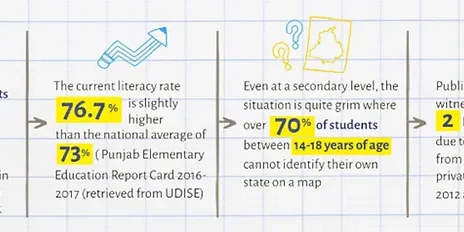Understanding Public Education in Punjab
Punjab forms one of our planet’s earliest known civilizations, the Indus Valley. It flourished and has consequently been ravaged by many kingdoms and powers under the rich basins of the many rivers running through it from which the state derives its name. Today, the Punjab state is widely known as the land of great saints and fighters. Agriculture and industry run its largely rural, mustard-colored landscape.
Despite having abundant resources and rich history as part of the ancient Indus Valley civilization, Punjab’s per capita income is 1482 USD, lower than the national average (as of 2021), and the unemployment rate of youth between the ages 15-24 was 30.3% (again more than the national average 2017-18), and the state featured second in the list in the injected drug use across the country (2019).
These issues are borne out of multiple factors, one of which is the state’s education crisis. In a 2017 study, it was found that only 36% of Grade 3 students could read Grade 2 text. 50% of students in Grade 5 cannot comprehend basic math operations. Consequently, at the secondary level, the situation is quite grim. 70% of students aged 14-18 need help identifying their state on a map. Government schools have witnessed a decline of over 0.2 million student strength due to migration to private schools. The state’s gross enrolment ratio in tertiary education was 30% (2018-19).
But, In the last few years, the education landscape has significantly changed, and Punjab was ranked number one in the National Achievement Survey – 2021. How has this happened? Where it all started?
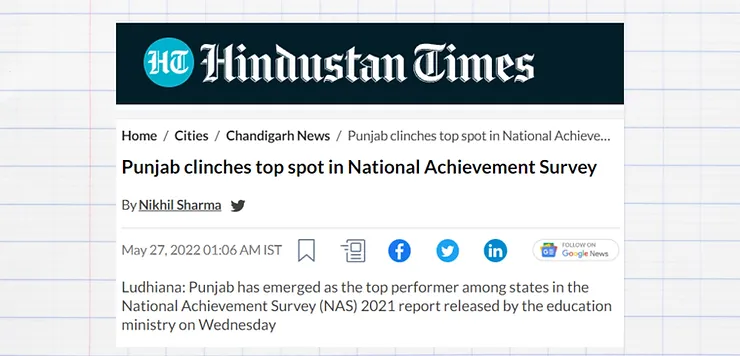
Strong Beginnings
The debut: In July 2019, four organizations, Sanjhi Sikhiya, ShikshaLokam, Mantra4Change & Samarthya, collectively approached the Department of School Education, Punjab, with an aim to contribute to the education system and a passion for supporting Punjab as a state. They did not go in with ready-to-implement plans – rather; they went in with curiosity to learn, experiences to build on, and a willingness to co-create with the government. Fortuitously, they were met with the same energy – “study the department and the schools first, then come in with a plan” was the response they first got on approaching department officials. Added to this was another key piece of advice that informed the design and work from then to date – the recommendation to focus on “+1” or incremental improvements in the existing system, which make a big difference in the long run.
The study: The collective followed the advice and did just that – they spent the initial weeks understanding the strengths, challenges, and realities of state-level actors and initiatives and school-level challenges. The study helped discover both great assets that the public school system already had (policies, people, innovative structures) and underlying challenges (usage of technology, focused capacity enhancement of leadership).
The gallery walk: At the end of this period, the collective came up with a list of 25+ ideas which were “+1” innovations: simple but powerful ideas for improving schools. Instead of going a traditional route, the collective shared these ideas through a gallery walk. Chart papers with drawings and post-it notes displayed the different ideas. Officials were intrigued by this innovative approach and walked from one corner of the room to another, engaging with each new idea as they moved. Walking to ideas and looking at chart papers also gave a more welcoming space for officials to interact with and share their feedback on the ideas being shared. While the collective had hoped for a go-ahead on the top 4-5 ideas, they were told to pursue all of them! At the end of the meeting, the organizations received advice that they all keep close to their hearts to this day – “there are already thousands of people in the department. We don’t need you to become an extended arm. Instead, you need to be a catalyst – support and motivate the existing people and systems to raise the bars of excellence”.
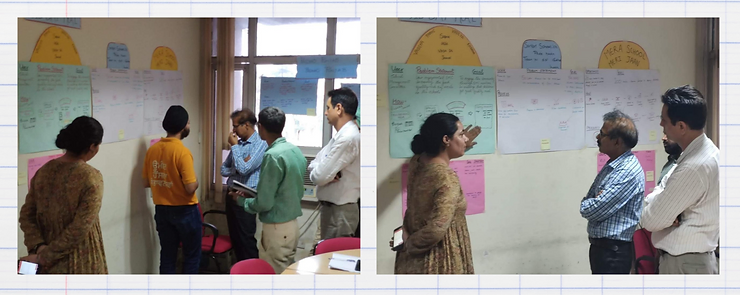
Full speed ahead: Working towards all of this was a big challenge that required all four organizations to come together and work towards a common goal. The organizations took on the challenge, agreed to come together with the education department, and formed the Punjab Education Collective in August 2019. The objective was to transform the public education system of Punjab by identifying challenges faced by the stakeholders on the ground, co-creating solutions with the state education department to address them, and improving the overall health of the education system.
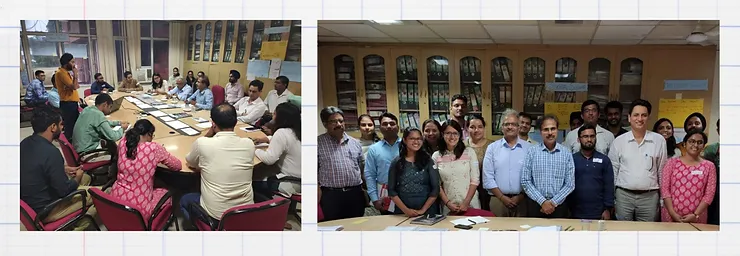
Cut to December 2022; The Punjab Education Collective was awarded – “The Collective Social Innovation Award” by the Schwab Foundation at the World Economic Forum for impacting 2.3 million students across 19,000 government schools in the state. What did the Punjab Education Collective do in the last three years that led to this recognition?
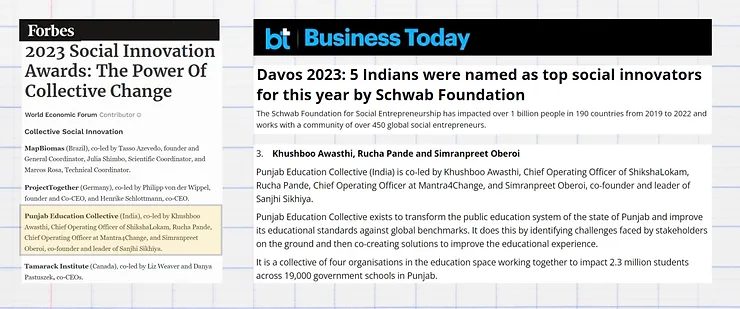
Members of The Collective: Who does what?
The four civil society organizations in the collective, or as we call them ‘members’ of the collective, are – Sanjhi Sikhya, ShikshaLokam, Samarthaya, and Mantra4change. In terms of the organizations’ previous efforts, Sanjhi Sikhya has undertaken deep work and developed a regional network in Punjab since 2017 through the Punjab Youth Leaders Program (an intensive two-year leadership program wherein bright young people work towards improving the quality of education in government primary schools). ShikshaLokam has worked on societal platform thinking, now called “Societal Thinking” to solve educational challenges with different state governments and civil society organizations. Samarthya works with state/district education departments in Punjab, Nagaland & Haryana to strengthen the structures and processes which promote parent participation, like Parent Teacher Meetings and School Management Committees. Mantra4Change has leveraged its research and design expertise and has seen success through its school and leadership programs in Karnataka, Uttar Pradesh, and Bihar. Mantra4Change and ShikshaLokam had also previously worked with the Delhi Commission for Protection of Child Rights to enable holistic school assessments across 5000+ schools in Delhi.
Today, each member has a key role as part of the collective. The Punjab State Education Department is an implementation and amplification partner providing the canvas to imagine and co-create solutions. Sanjhi Sikhya is a context-intensive partner specializing in elementary education and teacher development. Mantra4Change is a research and design partner focusing on school and leadership development. Samarthya ensures effective community and parent/guardian engagement. ShikshaLokam is a context-free technology partner, focusing on amplifying the programs and solutions statewide.
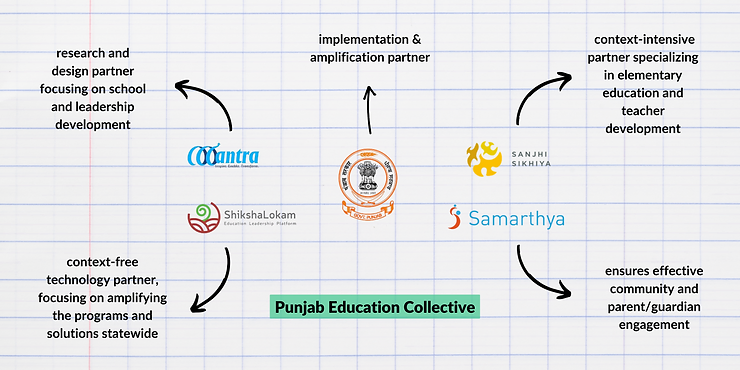
See, Solve & Sustain: Enabling the system to lead improvement.
Enabling education systems with deep-rooted challenges needs a systemic approach to improvement – an approach that not only takes the public education system’s effectiveness further, but also develops a “muscle for improvement” in the existing education system. In other words, enabling the system to see, solve, and sustain. Seeing is finding & validating needs and challenges in the system. Solving is finding ways to deal with the root cause of the problem effectively and not just solve the symptoms. Finally, Sustaining is creating a self-driven model that can continue to exist for a long period of time. Technology is a key enabler that the collective leverages to work within these frameworks.
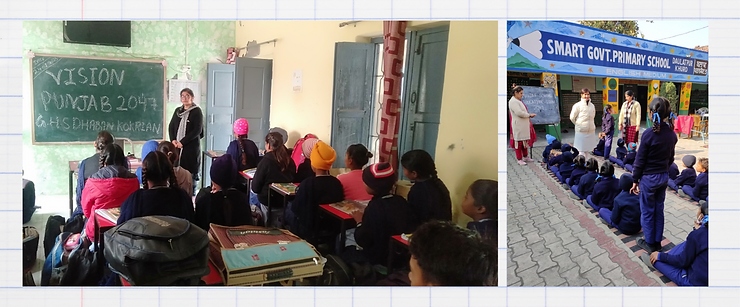
Improving the ecosystem’s ability to see: In systems where people are fire-fighting daily to solve urgent challenges, there is little space to look beyond and see the bigger picture. Additionally, trends and patterns around challenges that people are facing go unnoticed. This is the heart of enabling the system to “see”. What mechanisms may be integrated in the everyday functioning of schools that enable schools to leverage data to drive the school’s improvement? How might these mechanisms also help other actors at cluster, block, district, and state levels to understand trends and patterns in their geography? Understanding what is happening in schools across the state is a key foundation in developing school support systems.
Developing the ecosystem’s ability to solve: While understanding challenges is a key part of the solution, it doesn’t stop there. Multiple studies have shown that for systems in the early phases of their improvement journey, there needs to be clarity on the “how” of improvement – like building blocks that actors in the system can take up. Over time, this ability improves, and people can identify, develop, and take necessary steps toward improvement.
Developing the ecosystem’s ability to sustain: The journey of becoming a self-learning, self-healing, continuously improving system needs two strong pillars: institutionalization and connection. Institutionalization is critical in taking forward efforts even as individual actors in the system change. This involves creating policy and structure-level changes that help sustain practices. Connection with other ecosystem players helps develop a web of support the system can rely on as it continues on the improvement journey.
Leveraging technology: Leveraging technology as a tool is a great enabler in enabling the system to see, solve, and sustain—one such technology platform which has been critical in Punjab’s journey – is DIKSHA. The platform is accessible, especially with the country’s low internet penetration and speeds. It is a free, open-source, configurable, low-tech, inclusive technology infrastructure and offers a repository of microservices like observation, analysis, learning, and improvements.
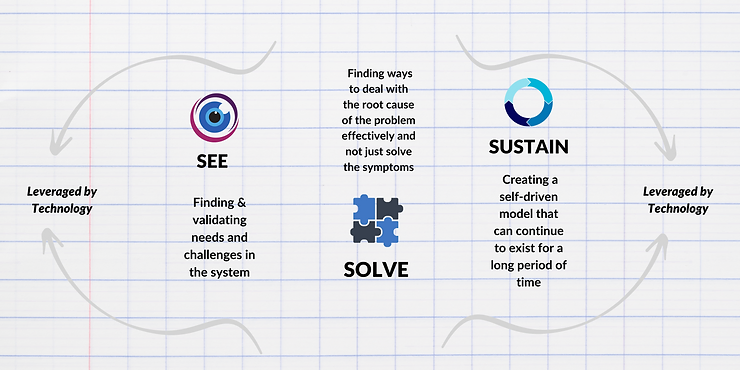
The Work of Collective
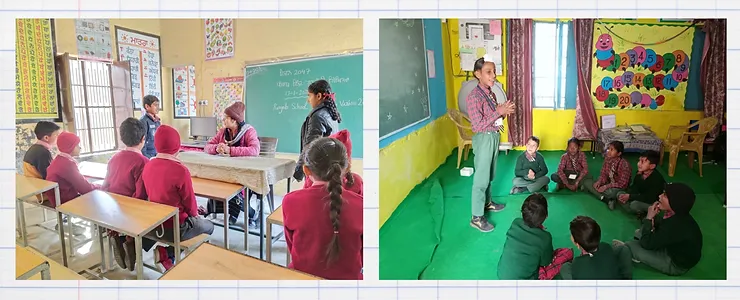
Education Leadership Development: One of the first challenges the collective focused on with the department was the role that instructional leaders in Punjab, Block, and District Mentors played in their school visits. While they recorded their observations in their own notebooks or documents, these did not result in insights for the mentors themselves or the department. The collective then collaborated with the department in developing a technology-enabled tool for recording school visits and activities, opening many layers to redefine ‘academic support’, and driving data-based decision-making in the system. While this helped bring shared visibility into schools, such a tool also enabled a shared understanding of the roles and responsibilities of instructional leaders.
As efforts to improve “visibility” and “ability to see” in the system were ongoing, so were efforts for improving the “ability to solve.” This was enabled through the “micro improvements” approach – small but powerful steps schools could take toward improvement. These included state-wide campaigns on reading where schools would take up projects like Reading Melas. School heads and instructional mentors were also engaged through capacity-building programs to motivate and enable them to lead improvement.
Improving Community Engagement: Aiming to strengthen school community relations and bringing forward parents/guardians’ voices, the collective ensured Parent-Teacher Meetings become consistent. State-wide Parent-Teacher Meetings were enabled in collaboration with the department, even going virtual during school closure. Over six online/offline PTMs were conducted in a single year, with an average of 70% parent attendance. Other community-facing campaigns include self-made smart schools and state-wide enrollment drives.
Streamlining Education Administration: The Punjab Education Collective has been instrumental in bringing about positive changes in the education administration in Punjab. The collective has successfully ensured the timely implementation of various micro-improvement programs by streamlining the administration and ensuring a clear division of roles and responsibilities. The collective has worked tirelessly to ensure that education administrators know their responsibilities and are equipped with the necessary tools and resources to carry out their duties effectively. As a result, Punjab has witnessed significant improvements, and students are benefiting from better facilities, quality education, and improved learning outcomes.
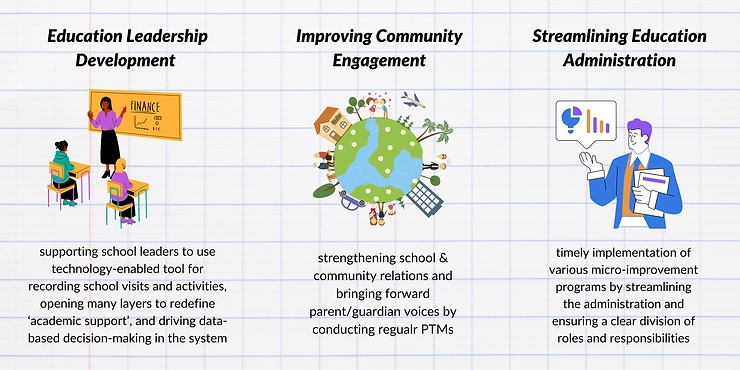
More Work – More Capital: Collective unlocking capital!
All the work that the collective has pulled together in the last few years was possible with the financial support it received. Shared credibility and networking have played a big role in pooling funds. There are four CSOs in the collective, and they all have different accreditations to their name. They can share the accreditations and appeal to more funders when they come together collectively. Additionally, funding collectives further strengthens the need to support a shared cause in which not just one but several organizations believe.
What makes the collective work?
The Punjab Education Collective is a team of professionals with different skill sets representing different organizations to solve a common problem at scale. While teamwork makes the dream work, it can also be challenging. There are many rough patches where the team is pushed back on various grounds and has to sit together, reflect on what’s going wrong, and course-correct. The collective started to work with certain assumptions and ways of working. Some of the ways the collective adopted worked, while they struggled with some and had to pivot. There are three key lessons that the Collective has learned over time:
Slow is Fast. When it comes to collective, systemic change, we may jump right in and solve it in isolation because it feels quicker. The Collective has learned that while this might feel like a quick solution, it is detrimental in the long run, as the ability to solve is restricted to only a few individuals. Instead, we must invest time and effort in bringing diverse voices, co-creating with stakeholders, and enabling collective action.
Contribute, not always Attribute. A key lesson that the collective had to learn was to let go of individual ego and not simply chase being able to attribute school-level impact to individual action. When it comes to collective and systemic change, we need to accept and find ways to contribute to improving schools rather than only looking for attribution.
Joints, not jigsaws. A common image displayed when communicating about partnerships is the infamous two puzzle pieces coming together, which seem to fit together so smoothly. However, this couldn’t be further from the truth. The Collective has had to learn that a better representation might be to imagine a carpenter, who first painstakingly saws wood from the tree (like from individual organizations), chop it into shape, and smoothen it with rough sandpaper, and then finally form a joint. Collectives take time and effort in smoothing edges to work together – and this is a continuous effort, not a one-time exercise. This also involves addressing critical challenges around the governance of the collective. Who reviews, who gives feedback to whom etc.? While some things can be explored and learned on the go, one of the collective’s learnings was that explicit governance structures need to be set initially – having seen the team struggle when it was not set early on. Adding to this is the diversity – different organizations of the collective have different team structures, ways of working, cultures, resources, and expertise. When they come together as a collective, there needs to be an optimal condition that helps the team to be cohesive, nimble, and productive, despite their organization’s structure and cultural differences.
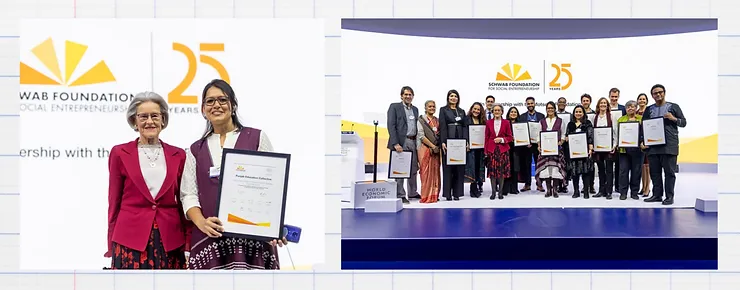
Conclusion
The Punjab Education Collective has shown how a – multi-stakeholder approach can ensure the development of systemic solutions that address the root cause of issues. Many conceptually brilliant solutions fail when it comes to implementation, as key stakeholders must be brought into the process. Bringing parties together in structured dialogues has helped the Punjab Education Collective generate a common vision and address contentious issues. Furthermore, as with any partnership, a multi-stakeholder approach has ensured learning across organizations, geographies, and sectors. Today, Punjab Education Collective stands as an example for other organizations with similar contextual challenges and calls for a collaborative approach and collective action.


